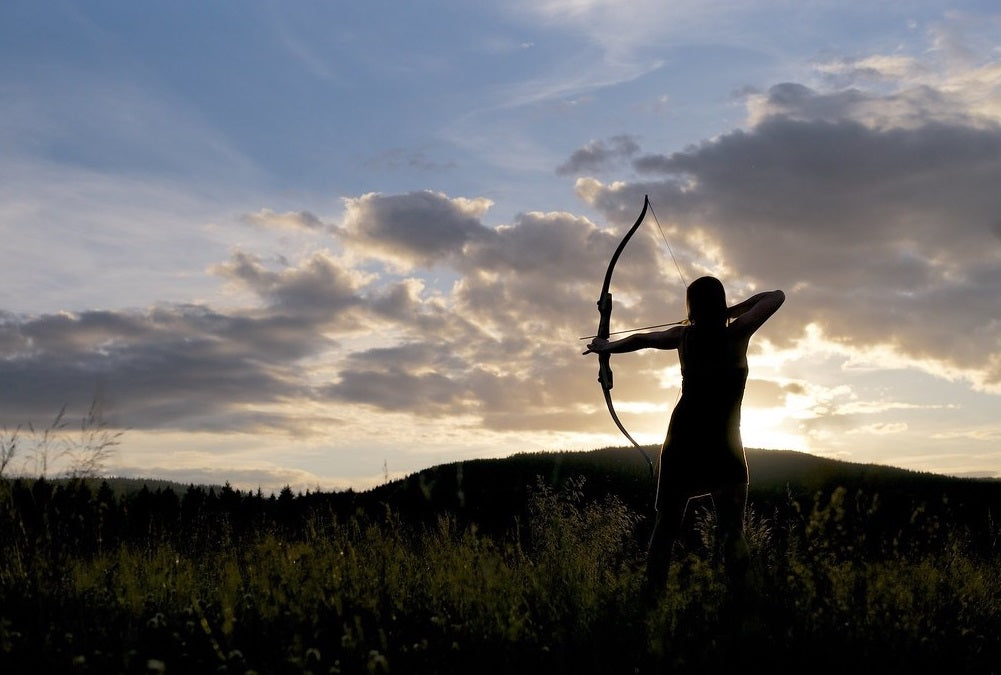March 24, 2014 by Teresa Johnson
Everyone who’s anyone in archery seems to be wearing slightly oversized, orangey sunglasses. And not just outside, either. They’re even using them for indoor shooting. Maybe that’s because they seem to win medals left, right and center while wearing these shades.
What’s up with that? We tagged along with five-time Olympian Butch Johnson to find out.
Johnson, despite winning two Olympic medals, is colorblind. His eyes are light-sensitive to the point of pain. And two years ago he stopped seeing his bow sight in sunlight.
“It would be fine when it was cloudy, but as soon as the sun came out, the sight would literally disappear,” Johnson said. “Sometimes it would happen at full draw, when the sun would come out from behind a cloud. The sight would disappear in mid-shot. It’s really bad. I’ve tried a bunch of different apertures, I’ve tried closing one eye, but nothing has really helped.”
Olympic medalist Butch Johnson tests the Pilla Outlaw X.
Enter Luke Milbury and Mike Silva, who work for Pilla, the company that makes these suddenly popular archery glasses. Pilla is a Connecticut-based company whose specialty is technical eyewear for the shooting sports.
“Everyone recognizes that vision is paramount, but Pilla is unique in that we are the only eyewear company focused on enhancing vision,” explains Milbury. “Where competitors have focused on fashion, Pilla’s priority is the functional science of helping athletes to see and thus to perform better. The archers who have tried our glasses have all loved the crisp definition, clarity and color enhancement they are getting.”
OK, vision is obviously important in archery. But can sunglasses really help archers reach the podium?
Pilla shades have a calming effect on archers, Milbury believes. “By managing the light properly, archers give their eyes the opportunity to relax. Thus the muscles in their face and neck will be more relaxed, giving them a better and more consistent form when drawing their bow. It’s also a tremendous mental benefit, especially with high-stakes competition. The glasses protect from glaring light, dust, wind and many other distractions, allowing archers to focus better and for longer periods of time.”
Ivana Buden, a top compound archer from Croatia, tries her Pilla glasses outdoors for the first time.
Johnson isn’t the only archer with eye issues who benefits from Pilla’s technology. Denmark’s Martin Damsbo, one of the world’s most successful compound archers, likes them, too. “I have always had a hard time finding sunglasses that were good enough for me to use when I shoot,” he said. “I have very sensitive eyes, so when we are shooting in heavy sunlight it’s always hard for my eyes to cope.”
Erika Jones, a multi-time world champion and the top world-ranked female compound archer, echoes this frustration. “I have never been able to shoot with sunglasses because I find them to be distracting,” she said. “Every frame I’ve tried has obstructed my line of vision, and every lens has distorted the target in an unnatural way.”
The glasses, it seems, deliver on Pilla’s promises. “I used my new Pilla glasses for the first time and was swept off my feet!” said Croatia’s Ivana Buden. “My eyes were relaxed, even though it was a bright sunny day. It made aiming so much easier!”
One key selling point for Pilla’s shades is that archers can swap out lenses on the same frame within seconds to address environmental changes. “We offer our products in one-, two-, and three-lens kits,” Milbury said. “We offer a lens for very bright, full-sun conditions, called the 10ED. We have a lens for indoor, and very low-light outdoor conditions called the 76HC. Last but not least, we have the 42ED, which is great for any and all conditions in between.”
What’s the key for recurve and compound archers alike? These glasses lack the plastic or metal “bridge” that rests on the nose. That means no lens distortion, and no need to reposition your head to compensate for the sunglasses. “More than just removing the nose, Pilla has created a system with perfect balance,” Milbury said. “There is no pressure on the nose or anywhere on the head. This provides superior comfort and protection.”
What about people who have challenges with the fit of sunglass frames? Milbury said that’s a key selling point for Pilla’s glasses. “All of our frames are adjustable in their own way,” he said. “We can pretty much fit any size/shape head into any of our framing systems. As a general guideline, Outlaw X7 and The Panther X2A are recommended for smaller archers. They can fit larger people as well, but they provide maximum adjustability in the frame.” Fear not, archers with larger heads: Pilla has frames for you, too.
Jones, highly selective about her technical equipment, swears by the optics: “Simply put, I believe (Pilla’s sunglasses) are the next big thing in tournament archery,” she said. “Not only do the lenses improve my sight picture by giving me crystal-clear vision, the unique color-filtration technology enables me to choose the appropriate lens for the given lighting, and allows my eyes to relax and not tire as quickly.”

Russia’s Albina Loginova rocking her Pilla shades indoors. Photo courtesy of ArcheryFoto.com, Copyright 2014, Dean Layton-James 2014. All Rights Reserved.
Braden Gellenthien, another of the world’s best compound archers, was one of Pilla’s early adopters. Why? “No one holds a candle to the quality of a PILLA Zeiss VIVX lens,” he said. “They give the added benefit of color filtration, so I can see the target lines with increased precision and focus in on the yellow target center.”
As for Johnson and his recurve bow, he’s still waiting for the snow to melt in Connecticut so he can put the outdoor lenses through their paces. He has already noticed differences, though: no pain in bright lighting, and a better fit for archery than any other sunglasses he’s used.
“I’ve been through a lot of glasses over the years, but these are impressive,” Johnson said. “There’s no bridge to deal with, no light entering at the bottom of the frame, and the lenses are extremely clear.”





